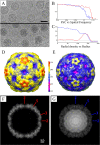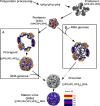Structures of the procapsid and mature virion of enterovirus 71 strain 1095
- PMID: 23637404
- PMCID: PMC3700288
- DOI: 10.1128/JVI.03519-12
Structures of the procapsid and mature virion of enterovirus 71 strain 1095
Abstract
Enterovirus 71 (EV71) is an important emerging human pathogen with a global distribution and presents a disease pattern resembling poliomyelitis with seasonal epidemics that include cases of severe neurological complications, such as acute flaccid paralysis. EV71 is a member of the Picornaviridae family, which consists of icosahedral, nonenveloped, single-stranded RNA viruses. Here we report structures derived from X-ray crystallography and cryoelectron microscopy (cryo-EM) for the 1095 strain of EV71, including a putative precursor in virus assembly, the procapsid, and the mature virus capsid. The cryo-EM map of the procapsid provides new structural information on portions of the capsid proteins VP0 and VP1 that are disordered in the higher-resolution crystal structures. Our structures solved from virus particles in solution are largely in agreement with those from prior X-ray crystallographic studies; however, we observe small but significant structural differences for the 1095 procapsid compared to a structure solved in a previous study (X. Wang, W. Peng, J. Ren, Z. Hu, J. Xu, Z. Lou, X. Li, W. Yin, X. Shen, C. Porta, T. S. Walter, G. Evans, D. Axford, R. Owen, D. J. Rowlands, J. Wang, D. I. Stuart, E. E. Fry, and Z. Rao, Nat. Struct. Mol. Biol. 19:424-429, 2012) for a different strain of EV71. For both EV71 strains, the procapsid is significantly larger in diameter than the mature capsid, unlike in any other picornavirus. Nonetheless, our results demonstrate that picornavirus capsid expansion is possible without RNA encapsidation and that picornavirus assembly may involve an inward radial collapse of the procapsid to yield the native virion.
Figures






Similar articles
-
Structural studies of bacteriophage alpha3 assembly.J Mol Biol. 2003 Jan 3;325(1):11-24. doi: 10.1016/s0022-2836(02)01201-9. J Mol Biol. 2003. PMID: 12473449 Free PMC article.
-
A 3.0-Angstrom Resolution Cryo-Electron Microscopy Structure and Antigenic Sites of Coxsackievirus A6-Like Particles.J Virol. 2018 Jan 2;92(2):e01257-17. doi: 10.1128/JVI.01257-17. Print 2018 Jan 15. J Virol. 2018. PMID: 29093091 Free PMC article.
-
The RNA-Binding Protein of a Double-Stranded RNA Virus Acts like a Scaffold Protein.J Virol. 2018 Sep 12;92(19):e00968-18. doi: 10.1128/JVI.00968-18. Print 2018 Oct 1. J Virol. 2018. PMID: 30021893 Free PMC article.
-
Virus particle dynamics derived from CryoEM studies.Curr Opin Virol. 2016 Jun;18:57-63. doi: 10.1016/j.coviro.2016.02.011. Epub 2016 Apr 14. Curr Opin Virol. 2016. PMID: 27085980 Review.
-
High-resolution 3D structures reveal the biological functions of reoviruses.Virol Sin. 2013 Dec;28(6):318-25. doi: 10.1007/s12250-013-3341-6. Epub 2013 Nov 6. Virol Sin. 2013. PMID: 24254888 Free PMC article. Review.
Cited by
-
Hand-Foot-and-Mouth Disease-Associated Enterovirus and the Development of Multivalent HFMD Vaccines.Int J Mol Sci. 2022 Dec 22;24(1):169. doi: 10.3390/ijms24010169. Int J Mol Sci. 2022. PMID: 36613612 Free PMC article. Review.
-
Serological detection and analysis of anti-VP1 responses against various enteroviruses (EV) (EV-A, EV-B and EV-C) in Chinese individuals.Sci Rep. 2016 Feb 26;6:21979. doi: 10.1038/srep21979. Sci Rep. 2016. PMID: 26917423 Free PMC article.
-
Thermal stabilization of enterovirus A 71 and production of antigenically stabilized empty capsids.J Gen Virol. 2022 Aug;103(8):001771. doi: 10.1099/jgv.0.001771. J Gen Virol. 2022. PMID: 35997623 Free PMC article.
-
Combined approaches to flexible fitting and assessment in virus capsids undergoing conformational change.J Struct Biol. 2014 Mar;185(3):427-39. doi: 10.1016/j.jsb.2013.12.003. Epub 2013 Dec 12. J Struct Biol. 2014. PMID: 24333899 Free PMC article.
-
Optimization of RT-PCR methods for enterovirus detection in groundwater.Heliyon. 2023 Nov 29;9(12):e23028. doi: 10.1016/j.heliyon.2023.e23028. eCollection 2023 Dec. Heliyon. 2023. PMID: 38149210 Free PMC article.
References
-
- Schmidt NJ, Lennette EH, Ho HH. 1974. An apparently new enterovirus isolated from patients with disease of the central nervous system. J. Infect. Dis. 129:304–309 - PubMed
-
- Reference deleted.
-
- Solomon T, Lewthwaite P, Perera D, Cardosa MJ, McMinn P, Ooi MH. 2010. Virology, epidemiology, pathogenesis, and control of enterovirus 71. Lancet Infect. Dis. 10:778–790 - PubMed
Publication types
MeSH terms
Grants and funding
LinkOut - more resources
Full Text Sources
Other Literature Sources

